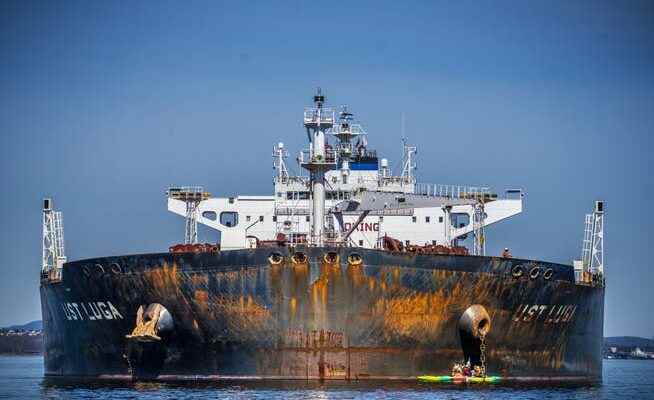Russia reacts to the EU price cap – but does not go to extremes. Unlike in Ukraine, the Kremlin cannot operate in the global oil market without considering losses.
Hopefully insured: the Russian oil tanker “Ust-Luga” near Oslo.
Russia’s warfare in Ukraine is marked by brute force. The lives of its own soldiers and Ukrainian civilians mean nothing to Moscow. But if the Kremlin can’t just hit it, it’s at a loss. This shows the Russian response to the western oil price cap. It is far less effective than was feared in some places – even if some media are now writing about an escalation.
Russia does not have a recipe yet
President Vladimir Putin signed a decree this week in response to the price cap agreed by the EU, the seven largest western industrialized nations (G-7) and Australia at the beginning of December. The cap aims to force international oil traders to pay less than $60 a barrel for Russian oil they receive by sea. Otherwise they are not allowed to insure their tankers with companies from these western countries. This is intended to depress the Kremlin’s export earnings. Western insurers play a very important role in oil trading.
The answer that the Kremlin has now given is cautious. It prohibits the export of crude oil if the sales contract refers to this price cap. This should apply from the beginning of February; later this should also be extended to petroleum products such as petrol or kerosene. More important is what the answer doesn’t include: for example, a floor price for Russian crude oil. Or a general export ban for countries that have agreed to the price cap. Unlike on the battlefield, the Kremlin leaves the two-handed sword in the closet.
The EU and the US no longer want to buy Russian oil by sea anyway. They decided that parallel to the price cap. Therefore, Putin’s retaliation will have little effect on them. The Kremlin’s goal is not to offend its remaining major buyers, such as India. The export ban does not currently affect them because the market price for Russian oil is below the $60 price cap anyway.
Urals crude oil is currently trading at just over $50 a barrel. This is a significant discount to the European benchmark Brent, which is trading at around $80, and can be explained by the political risks. It’s also a clear drop from the Urals yearly high of $100 hit in March.
A risk for the world market
The Western price cap is a compromise – which caused a lot of criticism. Even when it was decided, it was above the market price for the Urals. This also in order not to cause even more upheavals on the world market. After all, Russia is the world’s second largest oil exporter after Saudi Arabia. The downside is that the price of oil is still high enough to generate significant revenue for the Russian state budget. But they are not as high as they used to be. The household will make losses in the coming years.
It is a sign of helplessness that Putin does not go any further in his answer to the price cap. The Kremlin has been thinking about retorsion for months, but it still has no plan. The government should work out further measures, the decree says. You probably want to see how the price develops first.
Meanwhile, Russia reminds that it owns the Zweihander. Government officials are thinking loudly about a subsidy cut. A significant supply tightening could push the Urals price higher. But then Russia would also be the unilaterally acting aggressor on the international oil market – after having valued its reputation as a reliable energy supplier for decades.
You can refer to Benjamin Triebe, Editor for Business and Business Twitter follow.
